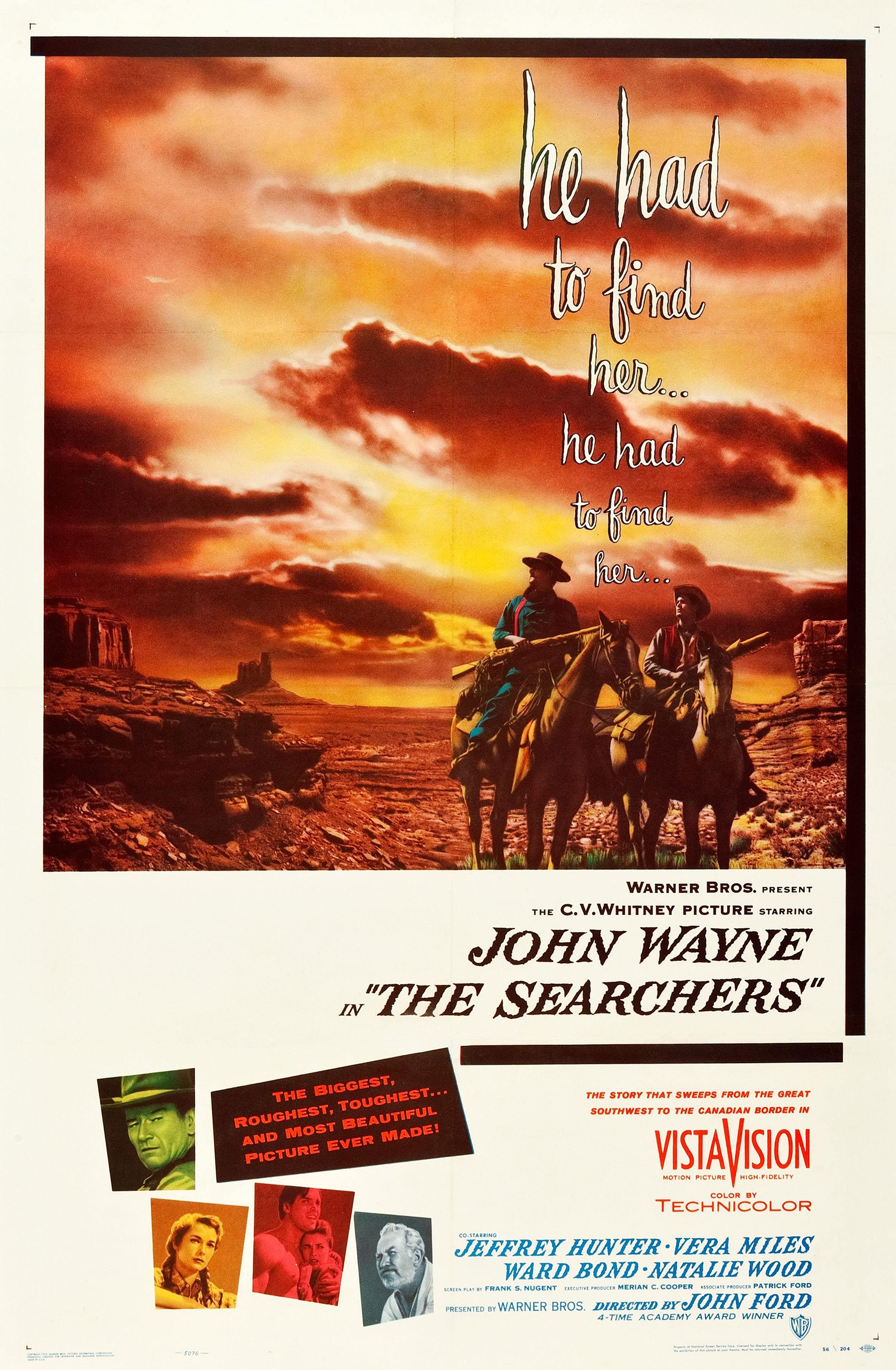
The Searchers
The Searchers is a 1956 American epic Western film directed by John Ford and written by Frank S. Nugent, based on the 1954 novel by Alan Le May. It is set during the Texas–Indian wars, and stars John Wayne as a middle-aged Civil War veteran who spends years looking for his abducted niece (Natalie Wood), accompanied by his adopted nephew (Jeffrey Hunter). It was shot in VistaVision on Eastmancolor negative with processing and prints by Technicolor.[3][4]
For other uses, see The Searchers (disambiguation).The Searchers
The Searchers
1954 novel
by Alan Le May
- May 16, 1956 (Chicago Theatre)[1]
119 minutes
United States
English
$3.75 million[2]
The film was a critical and commercial success. Since its release, it has come to be considered a masterpiece and one of the greatest and most influential films ever made. It was named the greatest American Western by the American Film Institute in 2008, and it placed 12th on the same organization's 2007 list of the 100 greatest American movies of all time.[5] Entertainment Weekly also named it the best Western.[6] The British Film Institute's Sight & Sound magazine ranked it as the seventh-best film of all time based on a 2012 international survey of film critics[7][8] and in 2008, the French magazine Cahiers du Cinéma ranked The Searchers number 10 in their list of the 100 best films ever made.[9]
In 1989, The Searchers was deemed "culturally, historically, or aesthetically significant" by the United States Library of Congress, and selected for preservation in its National Film Registry; it was one of the first 25 films selected for the registry.[10]
The Searchers was the first major film to have a purpose-filmed making-of, requested by John Ford. It deals with most aspects of making the film, including preparation of the site, construction of props, and filming techniques.[11]
Influence[edit]
The Searchers has influenced many films. David Lean watched the film repeatedly while preparing for Lawrence of Arabia to help him get a sense of how to shoot a landscape.[51] The entrance of Ethan Edwards in The Searchers, across a vast prairie, is echoed in the across-the-desert entrance of Sherif Ali in Lawrence of Arabia. Sam Peckinpah referenced the aftermath of the massacre and the funeral scene in Major Dundee (1965), and according to a 1974 review by Jay Cocks, Peckinpah's Bring Me the Head of Alfredo Garcia contains dialogue with "direct tributes to such classics as John Huston's The Treasure of the Sierra Madre and John Ford's The Searchers."[52][53]
Martin Scorsese's 1967 film Who's That Knocking at My Door features a sequence in which the two primary characters discuss The Searchers.[54] In 2012, in a Sight & Sound poll, Scorsese listed The Searchers as one of his all-time favorite films.[55][56]
Scott McGee, writing for Turner Classic Movies, notes "Steven Spielberg, Martin Scorsese, John Milius, Paul Schrader, Wim Wenders, Jean-Luc Godard, and George Lucas have all been influenced and paid some form of homage to The Searchers in their work."[37] Wenders' Palme d'Or-winning 1984 film Paris, Texas in particular has been cited for similarities.[57][58]
The film influenced several aspects of George Lucas' film saga Star Wars.[51] The scene in which Ethan Edwards discovers the flaming wreckage of his family homestead is reflected in 1977's Star Wars, wherein the character Luke Skywalker finds that his homestead has been burned and destroyed by Imperial Stormtroopers.[59][60][61] The Searchers was also an influence on the 2002 prequel film in the series, Star Wars: Episode II – Attack of the Clones. In the film, Anakin Skywalker learns that one of his family members has been abducted by a group of Tusken Raiders (though the character's mother is kidnapped, rather than a niece). Anakin massacres the kidnappers in vengeance, much like The Searchers' climactic battle in the Comanche camp.[59][60] The opening scenes of Rogue One mirror those of The Searchers: the piggy-tailed character of Jyn is hidden by her parents when their homestead is attacked in the same way little Debbie is saved by her parents when they are attacked by the Comanches.
Douglas Gordon's 1995 artwork, 5 Year Drive-By, stretches out The Searchers from the original 113-minute runtime to five years (reflecting the events of the movie taking place over a timespan of five years), playing at a speed of one frame every 24 minutes.[62][63][64]
The 2007 film Searchers 2.0 by Alex Cox includes many discussions of The Searchers as well as other revenge films. In the film, the characters attend a screening of a remake of The Searchers directed by Ted Post and starring James Mitchum as Ethan Edwards and Telly Savalas as Chief Cicatriz (Scar), though no such remake was ever made in reality (Ted Post had actually directed a remake of John Ford's Stagecoach).
Breaking Bad creator Vince Gilligan stated that the ending to the show's final episode, "Felina", was influenced by the film.[65]
The 2016 Canadian film Searchers is a partial remake of the film, in which an Inuit man in 1913 finds his wife and daughter have been kidnapped. However, co-director Zacharias Kunuk discarded the original's plot about conflicts between white people and indigenous peoples, instead using only Inuit characters. Kunuk explained racism was not an intended theme of his film.[66] Kunuk said he watched Western films in the Igloolik community hall as a boy, and declared The Searchers star John Wayne "was our hero".[67]
John Wayne's repeatedly used line "that'll be the day" inspired Buddy Holly to write the song "That'll Be the Day" after seeing the film in a theater in Lubbock, Texas.[68]